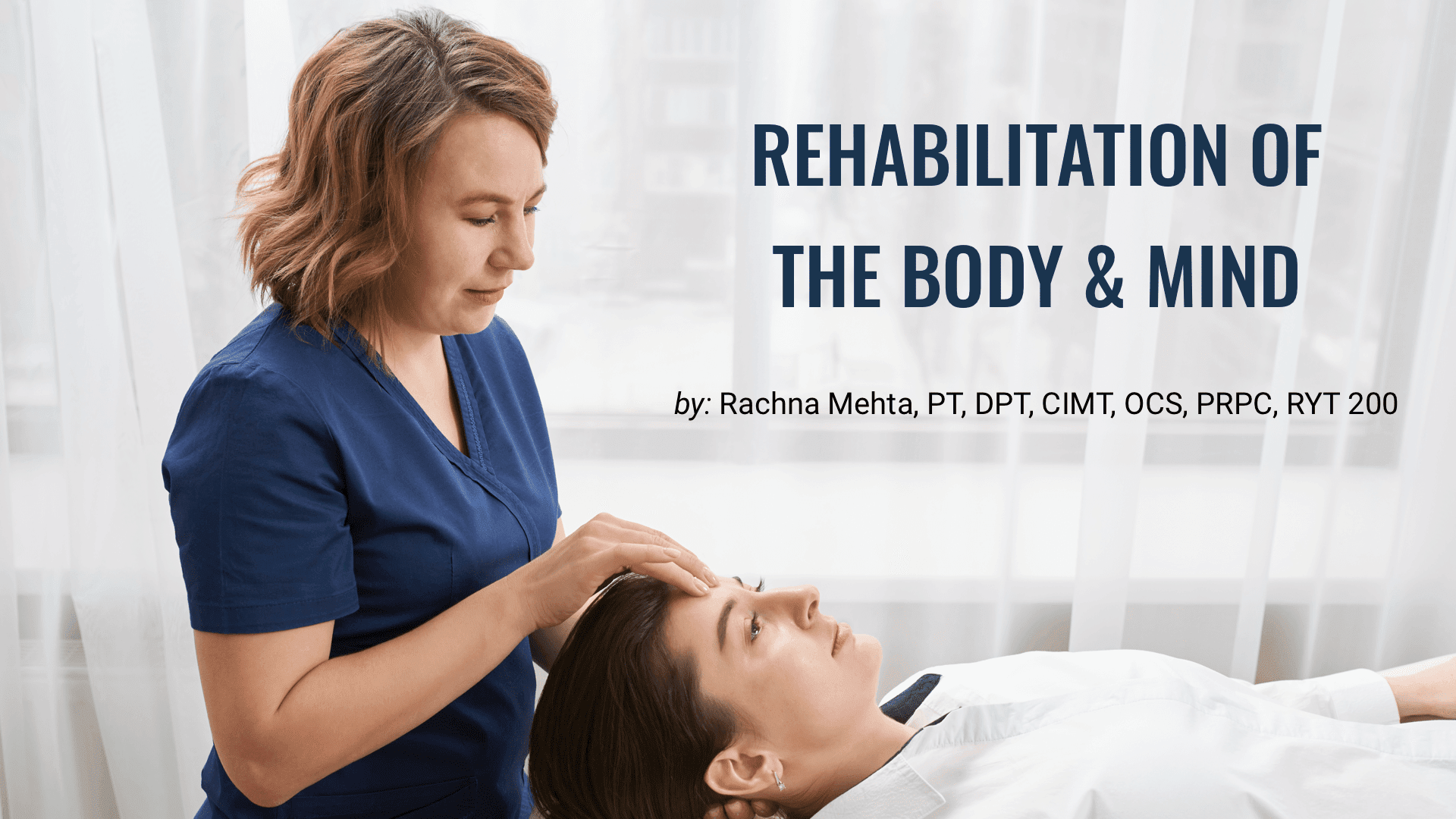Rehabilitation of the Body and Mind

Rachna Mehta, PT, DPT, CIMT, OCS, PRPC, RTY 200 is the author and instructor of the Acupressure for Optimal Pelvic Health course. Rachna brings a wealth of experience to her physical therapy practice and has a personal interest in various eastern holistic healing traditions.
According to the National Center for Complementary and Integrative Health (NCCIH), a branch of NIH, pain is the most common reason for seeking medical care (Pain: Considering Complementary Approaches published by National Center for Complementary and Integrative Health, 2019). There is a rising clinical interest in Integrative medicine for non-pharmacologic treatment options as our healthcare system faces a crisis of pills and opioid use (Monson, 2019).
A few days ago, I saw an elderly patient who walked in with 8/10 shoulder pain. The patient had fallen in his home a few weeks ago and had suffered a shoulder contusion. An x-ray showed no fractures, yet his shoulder pain was severe and unrelenting. He was on pain medications but still could not sleep at night.
Through further questioning and testing, I discovered that most of his pain was not in the joint itself but in the general area of the deltoid muscles and that he also had developed symptoms of secondary proximal biceps tendinitis. The patient was very anxious and upset due to the high pain and lack of sleep at night.
I decided to use an Integrative approach to address the patient's shoulder pain and anxiety. Thermotherapy is used in rehabilitation to reduce pain and stiffness and to increase mobility. It helps to relax muscles and increases circulation to the affected area, thus reducing pain and stiffness (Bin, 2022). I combined thermotherapy using an application of a hot pack on the patient’s shoulder with mindful breathing and gentle pressure on two potent Acupressure points CV 17 (center of the chest) and Yintang (EX-HN 3), which is in the center of the forehead between the eyes.
Within a few minutes, the patient reported feeling more relaxed, his pain levels improved to 4/10, and we were able to apply several interventions to improve his shoulder joint mobility. As part of his home program, I gave him instructions on gentle self-stretching and range of motion exercises within his pain threshold, mindful breathing, and an Acupressure self-care program with specific points listed for daily practice.
Anxiety is a very common psychiatric symptom and can also occur in many physical conditions. Due to the limitations of conventional pharmacotherapy, the discovery of nonpharmacologic treatments that alleviate anxiety effectively is clinically important. Yintang (EX-HN 3), an acupoint located between the eyebrows, is known to have a mentally stabilizing effect in Traditional Chinese Medicine (Kwon, 2017).
Acupressure has been studied extensively as a method for pain management. A meta-analysis of 15 studies showed that Acupressure is effective for relieving a variety of pains including dysmenorrhea, labor pain, low back pain, chronic headache, and other traumatic pain (Chen, 2012) and it is an effective Complementary and Alternative Medicine (CAM) therapy.
Acupressure derives its roots from Acupuncture which is part of Traditional Chinese Medicine (TCM). It involves applying pressure to specific Acupuncture points that lie along meridian lines to improve the flow of Qi in the body. This Qi can also be defined in our Western scientific perspective as the bio-electric energy that flows through a vast network of interstitial connective tissue connecting the peripheral nervous system to the central viscera (Langevin, 2002).
As the evidence continues to grow, both medical providers and patients are seeking effective non-pharmacological approaches for symptom relief. Clinically Acupressure shows promising results and adds value to an Integrative approach to Rehabilitation wherein we can combine holistic mindful-based interventions into our best evidence-based practices.
References- Pain: Considering Complementary Approaches published by National Center for Complementary and Integrative Health, 2019
- Monson E, Arney D, Benham B, et al. Beyond Pills: Acupressure Impact on Self-Rated Pain and Anxiety Scores. J Altern Complement Med. 2019;25(5):517-521
- Bin C, Cimin S, Li N, Wang L, Chen D. Thermotherapy for shoulder pain: A protocol for systematic review. Medicine (Baltimore). 2022;101(3):e28446. doi:10.1097/MD.0000000000028446
- Kwon CY, Lee B. Acupuncture or Acupressure on Yintang (EX-HN 3) for Anxiety: A Preliminary Review. Med Acupunct. 2018;30(2):73-79. doi:10.1089/acu.2017.1268
- Chen YW, Wang HH. The effectiveness of acupressure on relieving pain: a systematic review. Pain Manag Nurs. 2014;15(2):539-550. doi:10.1016/j.pmn.2012.12.005
- Langevin HM, Yandow JA. Relationship of acupuncture points and meridians to connective tissue planes. Anat Rec. 2002;269(6):257-265. doi:10.1002/ar.10185
- Kang H, An SC, Kim B, et al. Reduced Pain by Mind-Body Intervention Correlates with Improvement of Shoulder Function in People with Shoulder Pain: A Randomized Controlled Trial. Evid Based Complement Alternat Med. 2022;2022:6149052. Published 2022 Mar 24. doi:10.1155/2022/6149052
Acupressure Patient Testimonial
On March 5, 2023 I began experiencing searing pelvic pain. I went to the emergency room twice because the pain was so unbearable. I had an MRI, CT Scan, numerous ultrasounds, bloodwork, cultures and pelvic exams. All of the results were negative and the pain was spreading to my entire vaginal area. I saw a pain medicine doctor who thought my diagnosis could be pudendal neuralgia. He referred me back to my GYN. My gynecologist was stumped and recommended pelvic physical therapy with Rachna.
On April 20, 2023 I saw Rachna for the first time. At that point, my pain ranged between an 8/10 to a 10/10. Once the pain started, it seemed to spread and just become worse and worse throughout the day. The more pain I was in, the more anxious I became. I was caught in an endless loop of searing, burning pain to the left vaginal wall and perineum. During that first visit Rachna showed me a few acupressure points that I could use when the pain became overwhelming. I started using the third eye acupressure point and I immediately felt what I can only describe as energy and a sense of calm. The pain was still there, but I was able to breathe through it and focus my mind on the pressure point rather than just on the pain.
Over the course of the next month, I came to rely on those pressure points as an important tool to control (and accept) the pain. Eventually I was able to stop the pain from spreading. Instead of letting anxiety flame the pain, I could focus on the acupressure point and the feeling of energy that came with it instead of the pain. Once I was able to redirect my focus from pain to energy, my anxiety (which worsens my diagnosis) abated. I also found myself using acupressure to deal with stressful work/family situations or when I felt anxiety creeping up. Acupressure has become a coping mechanism that I lean on frequently.
My pain levels have been decreasing week to week. After one month of PT and acupressure, my pain is down to a soreness or 4/10 level. While I am still seeking treatment for pudendal nerve irritation, I'm confident that I can rely on acupressure to get me through.
Acupressure for Optimal Pelvic Health

Price: $450.00 Experience Level: Beginner Contact Hours: 12.50 hours
Description: This two-day course offers an evidence-based perspective on the application of Acupressure for evaluating and treating a host of pelvic health conditions including bowel, bladder and pelvic pain issues. The course explores a brief history of Acupressure, its roots in Acupuncture and Traditional Chinese Medicine (TCM) and presents current evidence that supports the use of complementary and alternative medicine as an adjunct to western medicine. TCM concepts of Meridian theory and energy channels are presented with scientific evidence of Acupoints transmitting energy through interstitial connective tissue with potentially powerful integrative applications through multiple systems.
Lectures evidence on use of potent Acupressure points and combinations of points for treating a variety of pelvic health conditions including chronic pelvic pain, dysmenorrhea, constipation, digestive disturbances and urinary dysfunctions to name a few. Key acupoints for decreasing anxiety, stress and bringing the body back to a state of physiological balance are integrated throughout the course.
Participants will be instructed through live lecture and demonstrations on the anatomic location and mapping of acupressure points along five major meridians including the spleen, stomach, kidney, urinary bladder and gall bladder meridians. Key associated points in the pericardium, large intestine, small intestine, lung and liver meridians as well as the governing and conception vessels will also be introduced. The course offers a brief introduction to Yin yoga and explores Yin poses within each meridian to channelize energy through neurodynamic pathways to promote healing across multiple systems. Participants will learn how to create home programs and exercise sequences and will be able to integrate acupressure and Yin yoga into their orthopedic and pelvic health interventions.
Course Date: October 14-15, 2023
By accepting you will be accessing a service provided by a third-party external to https://hermanwallace.com./







































